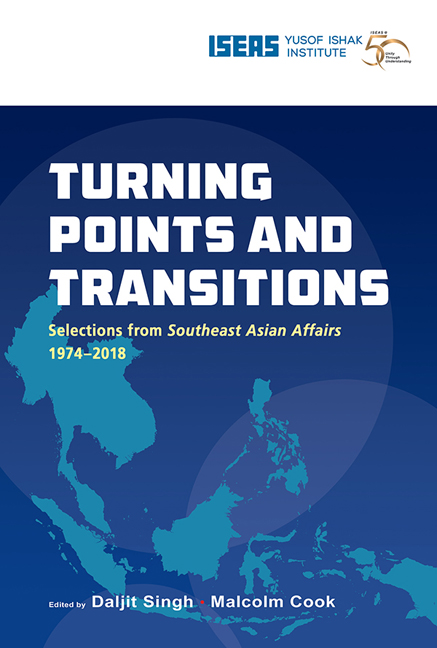Book contents
- Frontmatter
- Contents
- Message from the Director
- Foreword
- Foreword
- Introduction
- THE REGION
- BRUNEI
- CAMBODIA
- INDONESIA
- LAOS
- MALAYSIA
- MYANMAR
- THE PHILIPPINES
- SINGAPORE
- THAILAND
- VIETNAM
- Vietnam in Perspective (1975)
- Year One of Postcolonial Vietnam (1977)
- Vietnam, ASEAN and the Indochina Refugee Crisis (1980)
- Vietnam and ASEAN: A First Anniversary Assessment (1997)
Vietnam in Perspective (1975)
from VIETNAM
Published online by Cambridge University Press: 29 May 2019
- Frontmatter
- Contents
- Message from the Director
- Foreword
- Foreword
- Introduction
- THE REGION
- BRUNEI
- CAMBODIA
- INDONESIA
- LAOS
- MALAYSIA
- MYANMAR
- THE PHILIPPINES
- SINGAPORE
- THAILAND
- VIETNAM
- Vietnam in Perspective (1975)
- Year One of Postcolonial Vietnam (1977)
- Vietnam, ASEAN and the Indochina Refugee Crisis (1980)
- Vietnam and ASEAN: A First Anniversary Assessment (1997)
Summary
The wheel of fortune turns for most people but for the Vietnamese, it seems to have long remained immobile. Nearly two years ago, when the Paris Peace Agreement was signed, war-weary Vietnamese took heart that somehow the wheel would finally turn to their advantage. Although few were naïve enough to expect miracles, or that the next couple of years would be an easy time, many began to talk of post-war reconstruction. Most people had hoped that the framework established in the Paris Agreement, agreed to by signatory parties, would somehow transform the bloody struggle of the battlefields to a less violent competition in the political arena. Unfortunately their hopes did not materialize. Indeed, all that the Paris Agreement has achieved thus far has been to put an end to the direct U.S. involvement in the Indochina conflict and allow President Nixon to fulfil his promise of bringing the “boys” home. As far as Vietnam is concerned, the fighting has continued unabated; casualties are still high; and the prospects for a rapid political settlement is just as illusory today as when the Agreement was signed. With the South Vietnamese economy rapidly deteriorating, ordinary Vietnamese discover that living in “post-war” Vietnam is not much of an improvement from the days of the war itself.
This paper attempts to review and assess the significant political, economic, and social events that took place in South Vietnam in 1974. In so doing, the major trends of the country will be brought into sharper focus.
Major Political Trends
The year 1974 was one in which the government of the Republic of South Vietnam (GVN) has had to face some of the most serious challenges since it came into power. Jostled along by political currents, both external and internal, the political base of the government has been seriously eroded.
Adversary Challenges
On the military front, GVN's competition with the Provisional Revolutionary Government (PRG) and the Democratic Republic of Vietnam (DRV) has not diminished as a result of the cease-fire agreement. In fact, there has been little doubt as to the PRG's and DRV's capability of launching a full-scale military offensive.
- Type
- Chapter
- Information
- Turning Points and TransitionsSelections from Southeast Asian Affairs 1974-2018, pp. 713 - 722Publisher: ISEAS–Yusof Ishak InstitutePrint publication year: 2018

